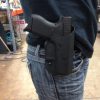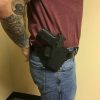We were very fortunate to take a pistol class with Massad Ayoob in Live Oak, Florida recently. Mr. Ayoob literally “wrote the book” on personal protection with a firearm with the release of In The Gravest Extreme in 1980 and the more recently released follow up Deadly Force. He has written countless articles for many of the top publications and websites related to law enforcement, firearms and self-defense and we think one of his best is Ten Commandments For Concealed Carry. We have chosen a few of our favorite “commandments” and added some of our own commentary below.
Commandment I: If you choose to carry, always carry, as much as possible
This one brings to mind the recent officer-involved shooting in Estero, Fl where a citizen “passerby” came to the rescue of a police officer who was being attacked by a criminal on the side of the road. This person was just driving down the interstate and surely did not expect to need a firearm in that moment. Think about your own daily routine. Do you work in a gun-free zone and therefore do not carry going to and from work? Do you leave your gun at home because your holster is uncomfortable? Do you ever find yourself saying “I’m just running to the store real quick, I don’t need it.” The bottom line: nobody expects to have to use their firearm, but you want to have that option available if the moment suddenly arises. As Mas says, “It’s not about convenience, it’s literally about life and death.”
Commandment II: Don’t Carry A Gun If You Aren’t Prepared To Use It
We have written before about establishing the proper mindset for everyday carry, but Mr. Ayoob puts it best when he writes, “we must always remember that criminals constitute an armed subculture themselves, living in an underworld awash with stolen, illegal weapons. They don’t fear the gun: they fear the resolutely armed man or woman pointing that gun at them. And, being predators, they are expert judges of what is prey, and what is a creature more dangerous to them than they are to what they though a moment ago was their prey. Thus, the great irony: the person who is prepared to kill if they must to stop a murderous transgression by a human predator, is the person who is least likely to have to do so.” Many defensive shootings are stopped before a shot is fired simply because the perpetrator backs down upon seeing a determined citizen with a firearm.
Commandment V: Know What You’re Doing
There is a common saying that most defensive gunfights are 3 shots in 3 seconds at 3 feet. Whether or not that is statistically accurate, you can be sure that there will be little room for errors, especially with your life, or the lives or your loved ones and/or bystanders at stake. The physiological effects of a stressful defensive encounter could include tunnel vision, auditory exclusion, sweaty and shaky hands, and most certainly a deterioration of your fine motor skills. Have you trained hard enough to respond quickly and accurately? The initial fight is just the beginning. Much of the emphasis of our class with Mr. Ayoob revolved around what happens after you survive the initial fight. The legal and emotional aftermath will be every bit as challenging and there are definitely right and wrong things to say and do in those moments to make sure you are giving yourself the best chance for a successful defense. Educate yourself. We suggest checking out the Armed Citizen’s Legal Defense Network as a first step.











